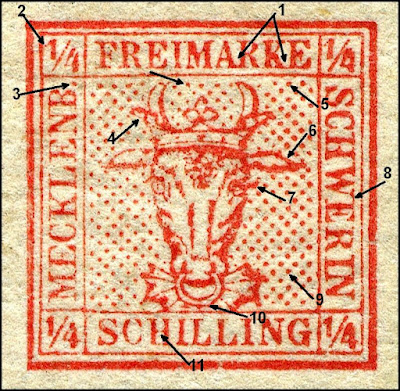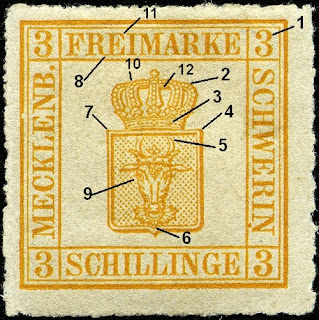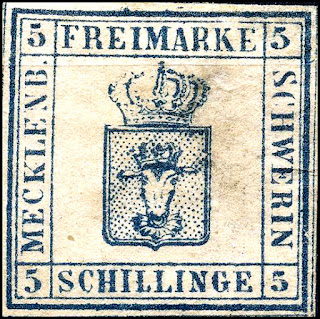When postage stamps were introduced in Mecklenburg-Schwerin on July I, 1856, there were 68 post offices. Three of them, Gustrow, Rostock and Schwerin, were main post offices (“Oberpostamter”), which supervised the other post offices. Only three new post offices were opened during the stamp period, so that there were 71 post offices on December 31, l867.
In addition to that there were eight post offices in railroad stations where post offices in the towns proper functioned; they were considered branch post offices.
There were traveling post offices on the main line from Hagenow to Rostock and on several supplementary lines.
The postal service was supervised by the Ministry of Finances and directed by a General Postal Directorate
In 1856, the number of pieces of mail was about 2.75 millions, therefore about 40,000 per post office and 4.5 per head of population.
Mecklenburg-Schwerin had several post offices on foreign. soil, namely at Hamburg, where the post office was opened in 1674 and closed on December 3l, 1867, with the only interruption during the French occupation, 1809 to 1814.
The postmarks are sought after.
Mi 1 – 1856.
Ox-head surrounded by inscription. Dotted background.
4 / 4 Schilling red.
Imperforate. Typographed.
Paper: Thin to medium heavy. dark gray red
Qty printed: 756,000 (Krotsch 1896)
4 / 4 Schilling red.
Imperforate. Typographed.
Paper: Thin to medium heavy. dark gray red
Qty printed: 756,000 (Krotsch 1896)
Genuine Features
1. AR & KE are joined. Others may also be joined
2. The serif extends to the frame
3. Lare dot after B
4. Left side ornament is generally broken
5. 4 dots on the right side
6. Ear longer and more shaded
7. Dot attached to eyebrow
8. WE & IN are joined
9. Dots are in astraight line
10. Ring does not touch frame
11. Crossbar very thin and may have a break
12. Eye is clearly defined
Mi 4 – 1864 June/July
dark gray red. Dotted background.
Paper: finely ribbed
Forgeries are generally the Mi 5b with painted on perfs & dots plus being chemically altered.
dark gray red. Dotted background.
Paper: finely ribbed
Forgeries are generally the Mi 5b with painted on perfs & dots plus being chemically altered.
On June 12th, 1864, a supply of 500 sheets (60,000 stamps) of the 4/4sch stamp was ordered from Berlin and delivered early in July.
The printers took t upon themselves to roulette the stamps in this supply and as the innovation was approved by the Mecklenburg authorities.
This rouletting necessitated a new arrangement of the little electrotypes. The groups of four were arranged with a space of 3 mm. between them, which allowed of a rouletting in line between each group.
The small quantity printed makes this stamp one of the higher CV German States stamp.
The printers took t upon themselves to roulette the stamps in this supply and as the innovation was approved by the Mecklenburg authorities.
This rouletting necessitated a new arrangement of the little electrotypes. The groups of four were arranged with a space of 3 mm. between them, which allowed of a rouletting in line between each group.
The small quantity printed makes this stamp one of the higher CV German States stamp.
Mi 5 – 1864 September
White background.
5a Finely ribbed paper 400,000
5b Ordinary paper 820,000
Brownish-red
Printing schedule
Date. Sheets. Value. Stamps
Aug. 10, 1864. 4,000 4/4sch 400,000
Jan. 9, 1866. 5,000 4/4sch 500,000
Feb. 23, 1867. 2,000 4/4sch 200,000
Aug. 24, 1867. 1,200 4/4sch 120,000
For a total of 1,220,000
White background.
5a Finely ribbed paper 400,000
5b Ordinary paper 820,000
Brownish-red
Printing schedule
Date. Sheets. Value. Stamps
Aug. 10, 1864. 4,000 4/4sch 400,000
Jan. 9, 1866. 5,000 4/4sch 500,000
Feb. 23, 1867. 2,000 4/4sch 200,000
Aug. 24, 1867. 1,200 4/4sch 120,000
For a total of 1,220,000
Special features of the Mi 5 that can be seen if an Mi 5 was altered to fake an Mi 4. These features can vary
1. Break in frame line
2. Prominent eyelashes
3. Bottom left “4” tends to be larger, fraction generally does not touch the frame.
4. The bottom of the “E’s” are wider than the top
5. This end tends to be closed off or the vertical frame line joins the main frame line.
6. The left side is generally more shaded.
7. The “r” generally extends to the frame.
8. The Bottom of this “S” tends to be wider than the top
9. The left horn tends to not be open and not pointed.
2. Prominent eyelashes
3. Bottom left “4” tends to be larger, fraction generally does not touch the frame.
4. The bottom of the “E’s” are wider than the top
5. This end tends to be closed off or the vertical frame line joins the main frame line.
6. The left side is generally more shaded.
7. The “r” generally extends to the frame.
8. The Bottom of this “S” tends to be wider than the top
9. The left horn tends to not be open and not pointed.
10. The 4 appears joined to the separator
Forgeries
The high CV Mi4 is often forged either from the 4/4 Schilling value of 1856, or the 4/4 Schilling value of 1864.
The effort to produce the valuable 4/ 4 Schilling value of 1864 was made by using faked rouletting on the 4/4 Schilling stamp of 1856.
However, the stamp grows smaller through this process.
The genuine stamp measures 24 1/2 mm. from roulette to roulette. Any specimen measuring otherwise must be regarded as a forgery.
Also the Mi4 4/ 4 Schilling, rouletted, is on laid paper
It is only necessary, therefore, to hold the stamp against the light to see whether or not the paper is laid. If not, it is generally a forgery.
And if the dots of the center piece cannot stand up to an immersion in warm water, one can be convinced that they are painted on.
The high CV Mi4 is often forged either from the 4/4 Schilling value of 1856, or the 4/4 Schilling value of 1864.
The effort to produce the valuable 4/ 4 Schilling value of 1864 was made by using faked rouletting on the 4/4 Schilling stamp of 1856.
However, the stamp grows smaller through this process.
The genuine stamp measures 24 1/2 mm. from roulette to roulette. Any specimen measuring otherwise must be regarded as a forgery.
Also the Mi4 4/ 4 Schilling, rouletted, is on laid paper
It is only necessary, therefore, to hold the stamp against the light to see whether or not the paper is laid. If not, it is generally a forgery.
And if the dots of the center piece cannot stand up to an immersion in warm water, one can be convinced that they are painted on.
Mi 2
Coat of arms and crown surrounded by inscription.
3 Schilling brown-yellow, orange.
Imperforate. Rouletted 12 ( Mi 7 – 1864). Typographed.
Between June 9, 1856 and Dec. 16, 1856, 438,000 stamps were delivered
3 Schilling brown-yellow, orange.
Imperforate. Rouletted 12 ( Mi 7 – 1864). Typographed.
Between June 9, 1856 and Dec. 16, 1856, 438,000 stamps were delivered
In September, 1865, the 3 schillinge appeared rouletted 11 like the other values.
The original plate of 1856 was used so that the stamps have smaller margins than those of the 5sch of the last issue which were printed in sheets of 100.
A supply consisting of 800 sheets, or 96,000 stamps was delivered on August 16th.
There was little room for the roulette lines, the size of the completed stamps being 23mm. square.
When a new supply was required in 1867 the plate was reconstructed so that it contained 100 stamps like that of the 4/4sch and 5sch.
These were so spaced that the stamps now measure a trifle more than 24 mm. square.
Two printings, each of 20,000 stamps, were made and these were delivered on July 11th and August 24th, 1867, respectively.
These were so spaced that the stamps now measure a trifle more than 24 mm. square.
Two printings, each of 20,000 stamps, were made and these were delivered on July 11th and August 24th, 1867, respectively.
Genuine Features
1. Numerals are well formed and do not touch the frame. The upper right “3” is slightly thinner than the lower left one.2. The arches of the crown consist of from left to right, 8, 10, 6, 10, 8 pearls. The crown is uniformly balanced.
3. There are 3 full diamonds, 2 half diamonds at the end and one small pearl between each diamond.
4. The right shield corner is rounded, the left is pointed.
5. Tip of left horn open, right one slightly
6. Small ring at crest – important trait
7. Pointed left side.
8. “R & E” generally joined at bottom.
9. Left eye is more detailed than the right one.
10. Small opening here
11. Serif of “E” point down to the right.
12. Bridge on both sides of venter.
Forgeries
Fournier 2nd class forgery1. Large “3” touches frame
2. “R & E” not connected
3. Small misshapen crown.
4. Crude trefoil
5. Break in frame
6. No ring
The forgery faults are primarily in the size of the serifs
Some lack of detail in the crown. Pointed ends on both sides of the shield
2. “B” very close to dot
3. No opening
4. Poorly shaped cross
5. Several breaks in frame
Scratch in front of top left 3
Mi 3 & Mi 8
Same design as before.
5 Schilling blue. Imperforate. Typographed.
5 Schilling brown. Rouletted 12. Typographed.
The color scheme for the Mecklenburg-Schwerin stamps was an unusual one, being based on the national colors, red, yellow and blue. The idea to use these three colors was the reason that the first issue was restricted to three denominations, namely 1s (4/4s) red, 3s yellow and 5s blue.
In 1864, to conform with the regulations of the German-Austrian Postal Union, which prescribed brown for the equivalent of the 3s denomination, the 5s stamps changed their color to brown.
Same design as before.
5 Schilling blue. Imperforate. Typographed.
5 Schilling brown. Rouletted 12. Typographed.
The color scheme for the Mecklenburg-Schwerin stamps was an unusual one, being based on the national colors, red, yellow and blue. The idea to use these three colors was the reason that the first issue was restricted to three denominations, namely 1s (4/4s) red, 3s yellow and 5s blue.
In 1864, to conform with the regulations of the German-Austrian Postal Union, which prescribed brown for the equivalent of the 3s denomination, the 5s stamps changed their color to brown.
The Mi 8 can be found in 3 paper formats
approx. 24.7 x 24.6 mm, plain paper
approx. 24.7 x 24.6 mm, very thick paper
approx. 23,5 x 23 mm. ribbed paper
approx. 24.7 x 24.6 mm, plain paper
approx. 24.7 x 24.6 mm, very thick paper
approx. 23,5 x 23 mm. ribbed paper
 |
| Mi 5 & Mi 8 |
Genuine Features
The characteristics of the 5s are essentially the same as the 3s
We need to concentrate on the traits of the upper part of the stamp
We need to concentrate on the traits of the upper part of the stamp
1. The dot is prominent and well centered between the “B” and the frame.
2. The top serif points down to the right.
3. 5 well rounded pearls. The bottom one shows a break in the two dozen or so samples I have seen so this may be a constant flaw?
4. Small opening here.
5. Well defined bridge.
6. Shadow only on the left side of the features.
When comparing, pay particular attention to the shape of the letters and particularly the serifs. Forgers tend to not get this right.
Slanted 5's
Lower first S is inverted
Last E middle bar too low
Ears equal and straight
No cross
First top r replaced by a P
Head completely wrong
Ears on different levels
5's all different
Large wide crown
H and N of Schwerin inclined
No shadow on right side of crown
No shadow on right side of crown
1. The outer frameline above the E of MARKE is weak
2. The letters K and L of MECKLENB are joined at top
1. There is a downward bend in thin frameline above the M of MARKE
2. There is a small break in the frame line below the M of MARKE
3. The frame lines are not quite in liner with each other
4. The 5 has a very thin spot or break in the upper right side curve of the body
Note inverted lower S
All 5's are different
G lower than other letters
Mi 6a & b
Coat of arms with crown.
2 Schilling lilac-carmine ( 1866) , lilac-gray ( 1867) .
Rouletted 12 Typographed.
When the new denomination, 2s, was introduced,the stamps were printed in violet.
The inks used were fairly uniform, and not many varieties are recorded, except for the 2s. This stamp was printed in violet, but due to deterioration of this ink, the last printing of this stamp, issued only in the last quarter of 1867, had a gray violet color which is very different from the first printing. This variety has a CV of 10 x the earlier version. Chemical alteration is the word of caution for this variety
Coat of arms with crown.
2 Schilling lilac-carmine ( 1866) , lilac-gray ( 1867) .
Rouletted 12 Typographed.
When the new denomination, 2s, was introduced,the stamps were printed in violet.
The inks used were fairly uniform, and not many varieties are recorded, except for the 2s. This stamp was printed in violet, but due to deterioration of this ink, the last printing of this stamp, issued only in the last quarter of 1867, had a gray violet color which is very different from the first printing. This variety has a CV of 10 x the earlier version. Chemical alteration is the word of caution for this variety
 |
| Mi 6 & 6a |
This issue has all the same traits as the 3s with a few added features.
1. The bottom tail points to the right, the right “2” point down (see below)
2. The top left serif of the “K” generally shows a break.
3. The 3rd pearl from the bottom has a dot in the center.
1. The bottom tail points to the right, the right “2” point down (see below)
2. The top left serif of the “K” generally shows a break.
3. The 3rd pearl from the bottom has a dot in the center.
This specimen from an auction is noted as a 6b with trimmed perfs.
Postmasters and the public were so used to cutting the stamps with scissors that they continued to do so when rouletted stamps were introduced. This is the reason that rouletted stamps are often found with the roulette clipped on one or more sides – excerpt from old stamp journal
Postmasters and the public were so used to cutting the stamps with scissors that they continued to do so when rouletted stamps were introduced. This is the reason that rouletted stamps are often found with the roulette clipped on one or more sides – excerpt from old stamp journal
Forgeries
Conclusion
Mecklenburg-Schwerin having joined the North German Confederation, its special stamps were superseded on January 1st, 1868, by the general issue for the Confederation.
Late in the same year or early in 1869 the remainders were purchased from the Post Office by Mr. G. Schnelle, of Schwerin for the apparent sum of $75.00.
These consisted of the following:
2sch lilac, 15,000 stamps
3sch yellow, 18,800 stamps
5sch bistre, 3,000 stamps
4/4sch red, 36,500 stamps
Envelopes.
1sch red, 26,400
2sch lilac, 25,000
3sch yellow,18,700
5sch bistre, 2,400
He apparently resold them to collectors for $2.40/100. A good time to buy some considering this lot would now easily fetch $1,500,000
Late in the same year or early in 1869 the remainders were purchased from the Post Office by Mr. G. Schnelle, of Schwerin for the apparent sum of $75.00.
These consisted of the following:
2sch lilac, 15,000 stamps
3sch yellow, 18,800 stamps
5sch bistre, 3,000 stamps
4/4sch red, 36,500 stamps
Envelopes.
1sch red, 26,400
2sch lilac, 25,000
3sch yellow,18,700
5sch bistre, 2,400
He apparently resold them to collectors for $2.40/100. A good time to buy some considering this lot would now easily fetch $1,500,000
Fournier Geneva Collection
Sheets of stamps sold by Fournier






































No comments:
Post a Comment
THANK YOU for the feedback. Your comment will be reviewed and appear on this blog within 24 hours
Do you have any pic to share? Use this code [img]your-image-url-here[/img]